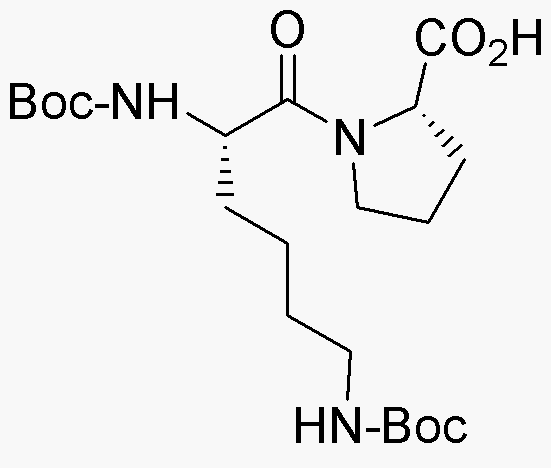Boc-Lys(Boc)-Pro-OH is widely utilized in research focused on:
- Peptide Synthesis: This compound serves as a key building block in the synthesis of peptides, particularly in solid-phase peptide synthesis, allowing for the creation of complex peptide chains with high purity.
- Drug Development: It plays a crucial role in the pharmaceutical industry for developing peptide-based drugs, enabling researchers to design and modify therapeutic agents effectively.
- Bioconjugation: The compound is used in bioconjugation processes, linking peptides to other biomolecules, which is essential in creating targeted drug delivery systems.
- Research in Immunology: It is applied in the development of peptide vaccines, helping researchers create immunogenic peptides that can stimulate an immune response.
- Protein Engineering: This chemical is instrumental in protein engineering, allowing scientists to modify protein structures for enhanced stability and functionality in various applications.
General Information
Properties
Safety and Regulations
Applications
Boc-Lys(Boc)-Pro-OH is widely utilized in research focused on:
- Peptide Synthesis: This compound serves as a key building block in the synthesis of peptides, particularly in solid-phase peptide synthesis, allowing for the creation of complex peptide chains with high purity.
- Drug Development: It plays a crucial role in the pharmaceutical industry for developing peptide-based drugs, enabling researchers to design and modify therapeutic agents effectively.
- Bioconjugation: The compound is used in bioconjugation processes, linking peptides to other biomolecules, which is essential in creating targeted drug delivery systems.
- Research in Immunology: It is applied in the development of peptide vaccines, helping researchers create immunogenic peptides that can stimulate an immune response.
- Protein Engineering: This chemical is instrumental in protein engineering, allowing scientists to modify protein structures for enhanced stability and functionality in various applications.
Documents
Safety Data Sheets (SDS)
The SDS provides comprehensive safety information on handling, storage, and disposal of the product.
Product Specification (PS)
The PS provides a comprehensive breakdown of the product’s properties, including chemical composition, physical state, purity, and storage requirements. It also details acceptable quality ranges and the product's intended applications.
Certificates of Analysis (COA)
Search for Certificates of Analysis (COA) by entering the products Lot Number. Lot and Batch Numbers can be found on a product’s label following the words ‘Lot’ or ‘Batch’.
*Catalog Number
*Lot Number
Certificates Of Origin (COO)
This COO confirms the country where the product was manufactured, and also details the materials and components used in it and whether it is derived from natural, synthetic, or other specific sources. This certificate may be required for customs, trade, and regulatory compliance.
*Catalog Number
*Lot Number
Safety Data Sheets (SDS)
The SDS provides comprehensive safety information on handling, storage, and disposal of the product.
DownloadProduct Specification (PS)
The PS provides a comprehensive breakdown of the product’s properties, including chemical composition, physical state, purity, and storage requirements. It also details acceptable quality ranges and the product's intended applications.
DownloadCertificates of Analysis (COA)
Search for Certificates of Analysis (COA) by entering the products Lot Number. Lot and Batch Numbers can be found on a product’s label following the words ‘Lot’ or ‘Batch’.
*Catalog Number
*Lot Number
Certificates Of Origin (COO)
This COO confirms the country where the product was manufactured, and also details the materials and components used in it and whether it is derived from natural, synthetic, or other specific sources. This certificate may be required for customs, trade, and regulatory compliance.


